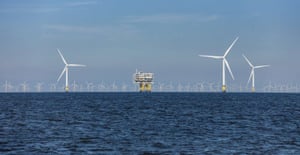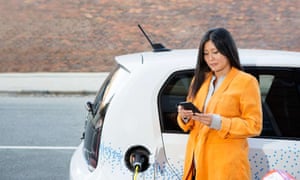A renewable-powered future is possible – and the UK is charting the way, one turbine at a time
Just off England’s Yorkshire coast, 174 wind turbines cut through the air, capturing energy and turning it into electricity – enough to power over a million homes. The Hornsea One project, inaugurated this year, is the world’s largest operational windfarm. Walney Extension, with 87 turbines – is not too far away in the Irish Sea. Both are among the handful of utility-scale offshore windfarms to have been built in the past half-decade in the UK, spurring the country’s transition to renewable energy.
The UK’s upscaling of offshore wind – with almost 11 GW of installed capacity, more than any other country in the world – offers a path forward for a world aiming to wean itself off fossil fuels. This is particularly notable for a once coal-reliant nation: just a decade ago, around 40% of the UK’s electricity came from coal. In 2019, that figure had dropped to about 2%, and by 2024, the government aims to phase out coal altogether. Today 44% of the UK’s electricity comes from renewable sources – a figure expected to grow to meet the UK’s climate goals of net-zero emissions by 2050 and 40 GW of offshore wind by 2030.
A range of factors have contributed to the UK taking a world-leading position in offshore wind but the last few years have been particularly productive, explains Duncan Clark, the head of region UK for Ørsted, the renewable energy company that developed and runs the Hornsea One offshore windfarm: “The Offshore Wind Sector Deal agreed with the UK Government has enabled ever closer collaborative working between government and the industry, reinforcing the effective and stable regulatory regime for offshore wind which has given developers, supply chain companies and the financial sector the confidence to invest. This in turn has supported and encouraged innovation, whilst also providing the competitive tension required to drive down prices at an unprecedented rate.”
Ramping up offshore wind is essential to accelerating the global energy transition, which many energy experts agree hinges on widescale electrification. Built at sea, offshore windfarms can provide stable green power at utility scale without taking up precious land area. This transformation is looking more and more like a reality: the Ocean Renewables Energy Action Coalition has recently suggested that 1,400GW of offshore wind is possible by 2050, which could power one-tenth of global electricity demand while saving over 3 billion metric tons of CO2 annually.
Green electric backbone
“When you look at overall pathways to net zero for the whole economy, it’s the power sector – zero carbon electricity – that is the backbone of all that,” says Melissa Lott, a senior research scholar at the Center on Global Energy Policy at Columbia University. In her research, which models technical pathways to decarbonization, Lott explains that “one of the key messages that comes through is that we need more electricity,” so that all technologies that run on fossil fuel combustion can be phased out.
The cost of renewable energy has also plummeted in the past decade. Today, power from wind and solar energy are cheaper than power from fossil fuel-derived energy in more than two-thirds of the world’s countries, according to BloombergNEF. The cost of electricity from offshore wind has fallen by more than 66% since 2012, making it cheaper to build offshore wind farms than new fossil-fuel power plants in northwestern Europe.
Yet despite the falling costs, there’s still a long way to a green energy transition at global scale. According to a recent analysis by the International Energy Agency, just 28% of electricity across the world comes from renewable sources, while about 60% comes from coal and gas. To build a livable future, gas and oil production will need to be phased out as quickly as possible, while renewable energy becomes the foundation for a new economy.
Streamlining the deployment of offshore wind power

Beyond lower costs, more will need to be done to incentivize the quick deployment of renewables, such as speeding up the permitting and siting of offshore wind, where the UK offers unique lessons.
“One of the things that we’ve seen in a bunch of different jurisdictions is this idea of streamlining environmental and planning processes to be able to lease out large chunks of land for offshore wind,” says Lott, referring to the permitting and leasing of land to utility-scale renewables. “The UK has really made progress when it comes to this leasing process.”
Even larger offshore wind projects are currently under development, which will help the UK reach 40GW. “We’ve now started offshore construction on Hornsea Two, which will be larger still at 1.4GW, and we have Hornsea Three and Four currently going through planning and development, so there is still a great deal more to come,” says Clark.
“The size and scale of offshore wind farms have increased considerably in recent years and we’re now seeing a new generation of projects taking shape,” he adds.
It’s also essential that projects are rigorously vetted through environmental standards and designed with an understanding of the marine ecosystem. “You need to know the seabed conditions, the water depth, the movement of the seabed, [and] wave patterns,” says Christina Aabo, the head of research and development for offshore wind at Ørsted. Aabo notes that this research process can take a few years.
In the future, Aabo envisions there will be major offshore wind energy hubs, which can transmit energy through many interconnected, mesh-like pathways. “I’ll call it complex and intelligent structure of wind power plants being interconnected, either to one or several countries,” said Aabo. This more dynamic structure can allow for the reliable transmission of a greater volume of energy.
Electrify everything
Ramping up renewables is not just critical to decarbonizing electricity. As renewable electricity becomes more abundant, it can then be used to decarbonize other sectors of the economy.
A greener building sector, for instance, will require retrofitting buildings to be energy-efficient while also transitioning from gas to electric heat. “Electrification of heat is a massive, massive opportunity,” says Sam Calisch, a scientist focused on decarbonization and an author of the report Mobilizing for a Zero Carbon America. In particular, Calisch highlights how heat pumps can electrify the heating sector, while cutting down on the amount of energy consumed.

Another opportunity is electrifying and expanding public transportation, while also transitioning from cars with internal combustion engines to electric passenger vehicles. For this to succeed, there needs to be policies that incentivize the adoption of electric vehicles and “realize the long-term savings of driving [electric vehicles],” says Calisch, referring to the eventual savings that come from the lower energy cost per mile as compared to vehicles with combustion engines. “This one is super critical because cars stay on the road for such a long time.”
There are also other heavy-duty transportation methods like trucks, trains, ships or planes that are more challenging to convert to renewable electricity. For instance, unlike electric vehicles, it’s not feasible for long haul flights to run on batteries. Instead, Calisch points to hydrogen or biofuels powering a plane as one possible solution that is actively being explored. He adds that it is important for hydrogen to come from renewable sources rather than fossil fuels.
Even though some technical questions remain, Calisch notes that this should not be a reason to delay moving forward with large-scale renewables. “We’ve got a long way to go in terms of deployment before these start to become serious roadblocks toward reducing emissions,” says Calisch. By the time these technologies are deployed, he explains, we will have likely already field-tested solutions at scale for these technical challenges.
After all, many solutions to the climate crisis that once seemed infeasible are now ready to power the world. It wasn’t too long ago that offshore wind was thought by many to be a pipe dream. “20 years ago, a lot of people were shaking their heads when you were telling them that you are working with wind energy,” says Aabo. Now, as the UK demonstrates, when governments set ambitious targets and enact clear policies, the build-out of wind and other green energy sources is actively shaping a low-carbon future.
